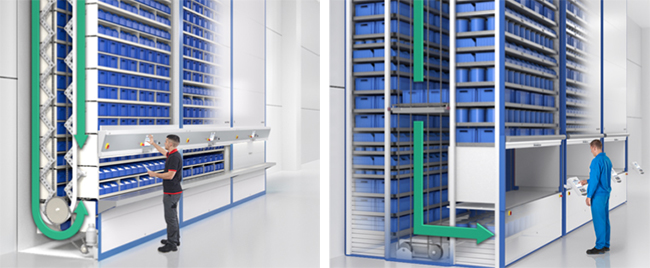VLMs Vs. Vertical Carousels: Critical Specification Factors
What are the differences between vertical lift modules and carousels?
Vertical carousels and vertical lift modules—VLMs for short—enhance organization, increase storage density, improve security and speed throughput. They serve components directly to pickers in waist-high ergonomic zones.
While these systems are similar from a functional standpoint and look similar from the outside, they can have different use cases and application requirements. Kevin, a Cisco-Eagle Dallas account executive, zeroes in on the differences in this video.
Shared attributes
- Both systems offer vertical, high-density storage and retrieval.
- Products are enclosed in secure lockable chassis in carousels and VLMs. This enhanced security is often a driving reason for companies who utilize them for high-value inventory.
- Storage density is key to both systems, with thousands of storage positions that take full advantage of the vertical cube. The same amount of SKUs stored on shelving in bins tend to take up significantly more space than in either a carousel or lift module.
- You eliminate needless warehouse walking and transit times with either system. Both deliver product to pickers in ergonomic picking zones, rather than forcing workers to walk, bend, extend and stretch for items on shelves or stored in racking.
Where do they diverge?

Left: vertical carousel. Right: vertical lift module
Despite their similarities, these systems are deployed in different situations and for specific applications. So what are the distinct differences, and how should that factor in to your operational needs?
Storage & delivery specifications: Ferris wheel vs. elevator

Vertical carousels have carriers in fixed locations attached to a chain drive that rotates inside the cabinet. Chain drives power the unit as it rotates and delivers the desired SKUs to the picking windows. The entire carousel inventory moves (this is reversible) every time anything is accessed.
In the case of vertical lift modules, a column of trays is stored in fixed locations within the cabinet. Between those storage positions, an extractor travels up and down to select a carrier tray. Only the required tray moves when it’s called for in the process.
Fitting in: dimensions and facility space factors
To enjoy these advantages, it’s crucial to select the right system for your footprint.
Widths: Both VLMs and carousels have the same width specifications, but VLMs can be twice as deep as carousels. VLM trays come in varying widths from 4 to 13 feet and depths of 2 to 3 feet, while both carousels and VLMs can accommodate product heights under 30 inches.
Heights:
- Vertical carousels have fixed heights, ranging from 8 to 32 feet, whereas VLMs have a much broader height range – from 13 to nearly 100 feet.
- The modular design of VLMs lets you customize by adding or removing modules.
- When a carousel is taller, it may have slower throughput due to longer periods of vertical travel. This may have an impact on the choice you make.
Carousels are ideal for spaces with lower ceilings, while VLMs can be much taller to take advantage of the vertical cube.
Throughput capacity comparisons

Above: Utilizing a VLM in order fulfillment operations
Carousels and VLMs both improve throughput, but how do they differ in that regard? Which is faster?
Carousels and VLMs typically move at similar speeds, although the actual performance varies depending on the load and application. In specific scenarios, carousels can be marginally faster than VLMs, but VLMs tend to have higher throughput rates for most applications. With a VLM, you can store the faster moving SKUs closest to the operator window, which means that those fast-movers only travel a few feet when accessed. Slower movers can be stored higher in the unit.
Because a carousel rotates the entire inventory each time it moves, the desired product may be in different locations at different times.
Capacity, load profiles and load handling
When it comes to handling heavier weights, VLMs are the best choice. This aspect is critical as it allows you to store a wider range of heavier parts compared to carousels. Standard VLMs boast capacities of up to 2,204 pounds per tray and up to 132,000 pounds per lift.
Moreover, VLMs are more versatile due to their adjustable storage positions. Unlike vertical carousels with equally spaced bins, VLM shelves can be reconfigured to accommodate shorter and taller loads, enabling the storage of various sizes and types of products. Carousels excel when dealing with goods of similar dimensions and lighter weight. If your inventory remains relatively static, carousels present a robust option to consider.
Download Our Systems & Automation Guide
Good systems design helps you build solutions that drive productivity and lower costs. Cisco-Eagle has completed many successful projects for hundreds of companies nationwide, helping clients create efficient material flow systems that deliver results. Our guide highlights what our systems group offers, and how we strive to be your trusted partner.
Download the guide today
Tags: Shoptalk, ergonomics, industrial carousels, order fulfilment
Scott Stone is Cisco-Eagle's Vice President of Marketing with 35 years of experience in material handling, warehousing and industrial operations. His work is published in multiple industry journals an websites on a variety of warehousing topics. He writes about automation, warehousing, safety, manufacturing and other areas of concern for industrial operations and those who operate them.




